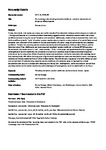Our evolving understanding of aeolian bedforms, based on observation of dunes on different worlds
| dc.contributor.author | Diniega, S | |
| dc.contributor.author | Kreslavsky, M | |
| dc.contributor.author | Radebaugh, J | |
| dc.contributor.author | Silverstro, S | |
| dc.contributor.author | Telfer, Matt | |
| dc.contributor.author | Tirsch, D | |
| dc.date.accessioned | 2016-11-22T20:28:15Z | |
| dc.date.available | 2016-11-22T20:28:15Z | |
| dc.date.issued | 2016-10-24 | |
| dc.identifier.issn | 1875-9637 | |
| dc.identifier.uri | http://hdl.handle.net/10026.1/6778 | |
| dc.description.abstract |
Dunes, dune fields, and ripples are unique and useful records of the interaction between wind and granular materials – finding such features on a planetary surface immediately suggests certain information about climate and surface conditions (at least during the dunes’ formation and evolution). Additionally, studies of dune characteristics under non-Earth conditions allow for “tests” of aeolian process models based primarily on observations of terrestrial features and dynamics, and refinement of the models to include consideration of a wider range of environmental and planetary conditions. To-date, the planetary aeolian community has found and studied dune fields on Mars, Venus, and the Saturnian moon Titan. Additionally, we have observed candidate “aeolian bedforms” on Comet 67P/Churyumov-Gerasimenko, the Jovian moon Io, and – most recently – Pluto. In this paper, we hypothesize that the progression of investigations of aeolian bedforms and processes on a particular planetary body follows a consistent sequence – primarily set by the acquisition of data of particular types and resolutions, and by the maturation of knowledge about that planetary body. We define that sequence of generated knowledge and new questions (within seven investigation phases) and discuss examples from all of the studied bodies. The aim of such a sequence is to better define our past and current state of understanding about the aeolian bedforms of a particular body, to highlight the related assumptions that require re-analysis with data acquired during later investigations, and to use lessons learned from planetary and terrestrial aeolian studies to predict what types of investigations could be most fruitful in the future. | |
| dc.format.extent | 5-27 | |
| dc.language | en | |
| dc.language.iso | en | |
| dc.publisher | Elsevier BV | |
| dc.title | Our evolving understanding of aeolian bedforms, based on observation of dunes on different worlds | |
| dc.type | journal-article | |
| dc.type | Review | |
| dc.type | Journal | |
| plymouth.volume | 26 | |
| plymouth.publication-status | Published | |
| plymouth.journal | Aeolian Research | |
| dc.identifier.doi | 10.1016/j.aeolia.2016.10.001 | |
| plymouth.organisational-group | /Plymouth | |
| plymouth.organisational-group | /Plymouth/Faculty of Science and Engineering | |
| plymouth.organisational-group | /Plymouth/Faculty of Science and Engineering/School of Geography, Earth and Environmental Sciences | |
| plymouth.organisational-group | /Plymouth/REF 2021 Researchers by UoA | |
| plymouth.organisational-group | /Plymouth/REF 2021 Researchers by UoA/UoA14 Geography and Environmental Studies | |
| plymouth.organisational-group | /Plymouth/Users by role | |
| plymouth.organisational-group | /Plymouth/Users by role/Academics | |
| dcterms.dateAccepted | 2016-10-04 | |
| dc.rights.embargodate | 2017-10-24 | |
| dc.rights.embargoperiod | 12 months | |
| rioxxterms.versionofrecord | 10.1016/j.aeolia.2016.10.001 | |
| rioxxterms.licenseref.uri | http://www.rioxx.net/licenses/under-embargo-all-rights-reserved | |
| rioxxterms.licenseref.startdate | 2016-10-24 | |
| rioxxterms.type | Journal Article/Review |


